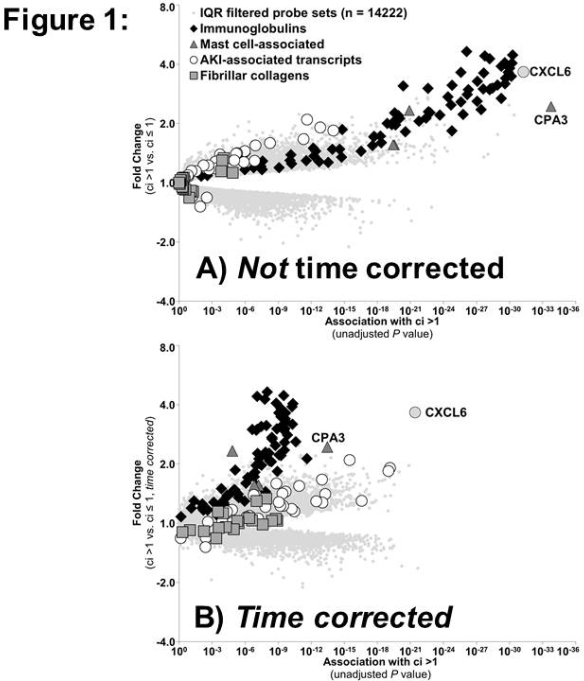The Molecular Landscape of Atrophy-Fibrosis in Human Kidney Transplants: The Dominant Role of Acute Parenchymal Injury
University of Alberta, Edmonton, Canada.
Meeting: 2015 American Transplant Congress
Abstract number: 260
Keywords: B cells, Immunoglobulins (Ig), Inflammation, Renal injury
Session Information
Session Name: Concurrent Session: Basic Mechanisms of Chronic Injury and Fibrosis
Session Type: Concurrent Session
Date: Monday, May 4, 2015
Session Time: 4:00pm-5:30pm
 Presentation Time: 5:00pm-5:12pm
Presentation Time: 5:00pm-5:12pm
Location: Room 121-C
We studied the effect of time post-transplant on atrophy-fibrosis (AF) and molecular associations with AF in 703 kidney transplant indication biopsies (bx) 3 days to 35 years post-transplant with histology and microarray analysis. Atrophy (ct) was strongly correlated with fibrosis (ci): Spearman r=0.90, thus we used ci as an estimate of AF.
We compared bx with high (ci>1) to those with little or no fibrosis (ci≤1). We visualized the relationship of all 14222 variance filtered probe sets with ci by plotting fold change for ci>1 vs. ci≤1 on the y-axis, and association strength (p-value) for ci>1 on the x-axis of Figure 1A. We annotated transcripts previously associated with fibrosis: immunoglobulin (black diamonds), mast cell (gray triangles), AKI-associated (white circles), as well as fibrillar collagen (gray squares) transcripts. Transcripts most strongly associated with fibrosis were immunoglobulins, CXCL6 and mast cell-associated CPA3, not AKI or fibrillar collagen transcripts.
Because time of bx post-transplant is highly correlated with histologic ci, but also immunoglobulins and mast cell transcript expression, we repeated the comparison of ci>1 vs. ci≤1 after correcting for time (Figure 1B). Time correction resulted in a massive reduction in association strength for the immunoglobulins and mast cell transcripts with AF (going from 10e-27 down to 10e-9). However, AKI-associated transcripts were more strongly associated with fibrosis. CXCL6 remained the top fibrosis-associated molecule. The association of fibrillary collagens with AFR remained weak.
These results confirm that the strongest molecular associations with fibrosis, immunoglobulins and mast cell transcripts, are actually confounded by their associations with time alone. On the other hand, time correction increases the correlation of strength of AKI-associated transcripts with AF, likely because they are expressed in any active injury or disease state in indication bx (regardless of time) as a reflection of parenchymal distress. The chemokine CXCL6 is one of the most robust single molecules associated with fibrosis (independent of time), and its relationship to long-term wound-repair processes deserves closer examination.
To cite this abstract in AMA style:
Venner J, Halloran P. The Molecular Landscape of Atrophy-Fibrosis in Human Kidney Transplants: The Dominant Role of Acute Parenchymal Injury [abstract]. Am J Transplant. 2015; 15 (suppl 3). https://atcmeetingabstracts.com/abstract/the-molecular-landscape-of-atrophy-fibrosis-in-human-kidney-transplants-the-dominant-role-of-acute-parenchymal-injury/. Accessed December 12, 2025.« Back to 2015 American Transplant Congress
